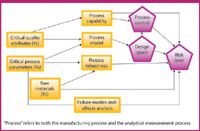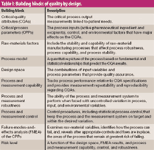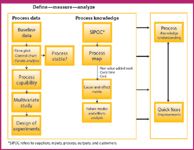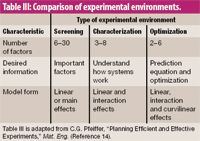Building a Framework for Quality by Design
The author describes the framework needed to implement QbD and achieve the deeper process understanding that is fundamental to QbD.
Driven by greater global competition and the growing impact of information technology, the pharmaceutical industry faces a need to improve its performance. Speed to market, product quality, regulatory compliance, cost reduction, waste, and cycle time are among the concerns that must be addressed in a systematic, focused, and sustainable manner. Quality by design (QbD), an approach offered by the US Food and Drug Administration, provides an effective tool for addressing these concerns. This article discusses the key steps for implementing QbD by providing a focus on how to develop the process understanding that leads to a useful design space, process-control methods, and characterization of process risk. Product and process life-cycle model validation is also addressed. Integrating these concepts provides a holistic approach for effectively designing and improving products and processes from the development of an active pharmaceutical ingredient to its manufacture and for other pharmaceutical processes.
Origins of QbD
Janet Woodcock, director of FDA's Center for Drug Evaluation and Research, defined the desired state of pharmaceutical manufacturing as "a maximally efficient, agile, flexible pharmaceutical manufacturing sector that reliably produces high-quality drug products without extensive regulatory oversight" (1). QbD has been suggested as the route to achieving Woodcock s vision. ICH Q8(R1) Step 2 defines QbD as a systematic approach to development that begins with predefined objectives, emphasizes product and process understanding and process control, and is based on sound science and quality risk management (2). QbD is not new. Its roots are in the work on design of experiments (DOEs) by R. Fisher, who did seminal work on design of experiments at the Rothamsted Experiment Station in England in the 1920s and 1930s, and by G. Box, professor at the University of Wisconsin, and his colleagues in the 1950s and 1960s (3,4). QbD was popularized in the 1990s by quality guru J. Juran, founder and chairman of the Juran Institute (5).
From an operational perspective, QbD is a systematic and scientific approach to product and process design and development that uses the following:
- Multivariate data acquisition and modeling to identify and understand the critical sources of variability
- Process-control techniques to ensure product quality and accurate and reliable prediction of patient safety and product efficacy
- Product and process design space established for raw-material properties, process parameters, machine parameters, environmental factors, and other conditions to enable risk management
- Control space for formulation and process factors that affect product performance.
QbD is useful for improving existing products, developing and improving analytical methods, and developing new products. The crux is implementing QbD in a cost-effective manner. The following issues are critical in that assessment:
- The recognition that the end result of successful implementation of QbD is the design space, process-control methodology and quantitative and qualitative estimates of risk level
- A strategy for identifying the critical process parameters that define the design space
- The creation of robust products and processes that sustain the performance of the product and process over time
- The use of change-management techniques to enable the cultural change required for success and long-term sustainability.
Building blocks of QbD
A lack of understanding of QbD in its entirety is a large stumbling block to its use. Stephen Covey, chairman of the Covery Leadership Center, points out that a successful strategy for any endeavor is to "begin with the end in mind" (6). Following Covey's advice, the first step of QbD is to understand the critical outputs of QbD and then identify the critical building blocks of QbD, namely, improving process understanding and control to reduce risk. The outputs of design space, process-control procedures, and the risk level (both quantitative and qualitative risk assessment) are consistent with this approach (2). Before results can be realized, however, the building blocks of QbD need to be assembled (see Figure 1 and Table I) as outlined below:
- Identify critical quality attributes (CQAs)
- Characterize raw-material variation
- Identify critical process parameters (CPPs)
- Characterize design space
- Ensure process capability, control, and robustness
- Identify analytical method capability, control, and robustness
- Creates process-model monitoring and maintenance
- Offers risk analysis and management (7).

Figure 1: Building blocks of quality by design. Xs are critical process parameters. Ys are critical quality attributes. (FIGURE IS COURTESEY OF THE AUTHOR)
Attention must be paid to the product formulation, manufacturing process, and analytical methods. Measurement is a process that needs to be designed, improved, and controlled just as any other process. The QbD building blocks provide a picture of the critical elements of the roadmap.

Table I: Building blocks of quality by design. (TABLE IS COURTESEY OF THE AUTHOR)
Increased process understanding
Process understanding is fundamental to the whole QbD approach. Regulatory flexibility comes from showing that a given process is well understood. According to FDA, a process is generally considered to be well understood when the following conditions are met:
- All critical sources of variability are identified and explained
- Variability is managed by the process (8).
Product-quality attributes can be accurately and reliably predicted within the design space established for the materials used, process parameters, manufacturing, environmental and other conditions.
Process understanding is needed not only for product and process development, but also for successful technology transfer from development to manufacturing and from site-to-site, which includes transfer to contract manufacturing organizations (9–11). It is very difficult, if not impossible, to successfully and effectively create, operate, improve, or transfer a process that is not understood.

Figure 2: The interrelationship between variation, process understanding, and risk reduction. (FIGURE IS COURTESEY OF THE AUTHOR)
Process variation, process understanding, process risk, and compliance are related (see Figure 2). Understanding and reducing process variation increases process understanding, which in turn leads to reduced risk and improved compliance. QbD and its associated statistical tools help increase the understanding of process variation. The tools for developing process understanding (see Table II) include those of process analytical technology (PAT) as outlined below:
- Multivariate tools for experiment design, data acquisition, and analysis
- Process analyzers
- Process-control tools
- Continuous improvement
- Knowledge management

Table II: Tools for developing process understanding. (TABLE IS COURTESEY OF THE AUTHOR)
The Lean Six-Sigma tools are also useful in developing process understanding (see Figure 3) (12). A combination of some, or all, of the PAT and Lean Six-Sigma tools may be applicable to a single unit operation or to an entire manufacturing process and its quality assurance.

Figure 3: Tools for developing process understanding. (FIGURE IS COURTESEY OF THE AUTHOR)
Studies critical to developing and assessing process understanding include assessment and improvement of the following:
- Process stability, capability, and robustness
- Measurement of process control, quality, and robustness
- Process models developed using statistical DOEs and other techniques to predict process performance and create the design and control spaces
- Understanding of how the process can fail using failure-modes-and-effects analysis (FMEA).
After conducting these studies, the risks in the process and thus to the patient are better quantified and understood, thereby enhancing compliance. The identification, characterization, analysis, and interpretation of variation in the performance of the product, process, and analytical methods are central to these studies.

Case study: quality by design in late-stage development
Design space
Although all the building blocks of QbD are important, the creation and use of the design space is arguably the most important aspect of QbD. The design space is the multidimensional combination and interaction of input variables (e.g., material attributes) and process parameters that have been demonstrated to ensure quality (2). Within the design space is the control space or the combination of variables and limits used to keep the process on target. A process can have more than one control space. By definition each control space is a subset of the design space.
A key question is how to create the design space, particularly when products are often locked into a design space before the process is well understood. The following two-phase approach is recommended:
- Create the design space during the development phase by focusing on minimizing risk and paying close attention to collecting the data that are most critically needed to speed up development and to understand the risk levels involved
- After the process has been moved into manufacturing, collect data during process operation to refine the process model, design space, and control space as additional data become available over time.
Getting the right set of variables (i.e., critical process parameters, input variables such as raw-material characteristics and environmental variables) in the beginning is critical. Sources of variables and risk can be obtained in several ways. Interactions between raw-material characteristics and process variables are ever-present and difficult to understand with the use of statistically designed experiments.
Identifying the critical variables often begins what is called "tribal knowledge," meaning what the organization knows about the product and process under study. This information is combined with the knowledge gained in development and scale-up, a mechanistic understanding of the chemistry involved, literature searches, and historical experience. The search for critical variables is a continuing endeavor throughout the life of the product and process. Conditions change, and new knowledge is developed, thereby potentially creating a need to refine the process model and its associated design and control spaces.
The resulting set of variables are subsequently analyzed using a process map to round out the list of candidate variables, the cause-and-effect matrix to identify the high-priority variables, and the FMEA to identify how the process can fail. Variables that require further experimentation using DOE and measurement-system analysis will become evident (13).
Identifying potential variables typically results in a long list of candidates, so a strategy for prioritizing the list is needed. In the author's experience and that of others, the DOE-based strategy-of-experimentation approach (see Table III), developed at DuPont (Wilmington, DE), is a very effective approach (14). Developing an understanding of the experimental environment and matching the strategy to the environment is fundamental to this approach. A three-phase strategy (i.e., screening, characterization, and optimization) and two-phase strategy (i.e., screening followed by optimization and characterization followed by optimization) are the most effective. In almost all cases, an optimization experiment is run to develop the model for the system that will be used to define the design space and the control space.

Table III: Comparison of experimental environments. (TABLE IS COURTESEY OF THE AUTHOR)
The confirmation (i.e., validity check), through the experimentation model used to construct the design space and control space is fundamental to this approach. Confirmation experiments are conducted during the development phase. The model is confirmed periodically as the process operates over time. This ongoing confirmation is essential to ensure that the process has not changed and that the design and control spaces are still valid. The ongoing confirmation of the model happens during the second phase of the development process, as previously described.
Process and product robustness
Process and product robustness are critiommunicationsInc.2007cal to the performance of the process over time. Design space should incorporate the results of robustness experiments. In general terms, robust means that the performance of the entity is not affected by the uncontrolled variation it encounters. Accordingly, a product is robust if its performance is not affected by uncontrolled variations in raw materials, manufacture, distribution, use, and disposal (15). Examples of robust products are user-friendly software and pharmaceuticals that have no side effects regardless of how or when they are administered.
A process is robust if its performance is not affected by uncontrolled variation in process inputs, process variables, and environmental variables. Robust processes are those processes that perform well when faced by large variations in raw-material characteristics and differences in ambient conditions and operating teams.
QbD changes
Using QbD creates a paradigm shift from the usual approach to development (16). QbD thus represents a cultural change that must be addressed with change-management techniques such as the eight-stage change model developed by Kotter and associated change-management tools (17–18). The importance of change management is not recognized by many organizations that deploy QbD and other improvement techniques. As a result, the promise of the associated change initiative is seldom realized even in minor terms.
Conclusion
As shown in other industries and more recently in the pharmaceutical industry, QbD is an effective method for developing new products and processes. QbD enables effective technology transfer and the optimization and improvement of existing processes. QbD works because it fosters process understanding that is fundamental to the creation of the design and control spaces and to sustain performance. The design space is critical to the success of QbD because it produces the following: performance on target and within specification at minimal cost with fewer defective batches and deviations; greater flexibility in process operation; and the ability to optimize manufacturing operations without facing additional regulatory filings or scrutiny. This process understanding enables the reduction of process variation and the creation of process-control systems that are based on sound science and quality risk-management systems.
QbD works beyond development and manufacturing to include functions such as technology transfer, change control, deviation reduction, and analytical methods development and improvement. All work is a process, and QbD is an effective method for improving processes. QbD s use will no doubt broaden in the future, and its application in the life sciences is almost without bounds.
Ronald D. Snee, PhD, is president of Snee Associates, 10 Creek Crossing, Newark, DE, 19711 tel: 610.213.5595, fax 302.369.9971, ron@sneeassociates.com
References
1. J. Wechsler, "FDA Moves to Streamline CMC Review, Promote Drug Quality," Pharm. Technol. 29 (12), 36–42 (2005).
2. ICH, Q8(RI) ICH Harmonized Tripartite Guideline: Pharmaceutical Development, (Geneva, Switzerland, Nov. 10, 2005).
3. R.A. Fisher, Design of Experiments (7th edition, Oliver and Boyd, London, 1960).
4. G.E.P. Box, J.S. Hunter, and W.G. Hunter, Statistics for Experimenters—Design, Innovation, and Discovery (John Wiley and Sons, New York, 2005).
5. J.M. Juran, Juran on Quality by Design: The New Steps for Planning Quality into Goods and Services (Free Press, New York, 1992).
6. S.R. Covey, The 7 Habits of Highly Effective People (Simon and Schuster, New York, 1989).
7. R.D. Snee, "Quality by Design: Four Years and Three Myths Later," Pharma Processing 26 (1), 14–16 (2009).
8. FDA, PAT—A Framework for Pharmaceutical Development, Manufacturing and Quality Assurance (Rockville, MD), 2004.
9. P. Alaedini, R.D. Snee, and B.W. Hagen, "Technology Transfer by Design—Using Lean Six Sigma to Improve the Process," Contract Pharma 9 (4), 4–9 (June 2007).
10. R.D. Snee, "Lean Six Sigma and Outsourcing—Don't Outsource a Process You Don't Understand," Contract Pharma 8 (8), 4–10 (2006).
11. R.D. Snee, W. J. Reilly, and C.A. Meyers, "International Technology Transfer By Design," Int. Pharm. Ind. 1 (1), 4–10 (2008).
12. R.D. Snee and R.W. Hoerl, Six Sigma Beyond the Factory Floor— Deployment Strategies for Financial Services, Health Care, and the Rest of the Real Economy (Prentice Hall, New York, 2005).
13. M.H. Hulbert et al., "Risk Management in Pharmaceutical Product Development—White Paper Prepared by the PhRMA Drug Product Technology Group," J. Pharm. Innov. 3 (1), 227–248 (2008).
14. C.G. Pfeiffer, "Planning Efficient and Effective Experiments," Mater. Eng, 35–39, May 1988.
15. Product Quality Research Institute (PQRI) Robustness Workgroup, "Process Robustness—A PQRI White Paper," Pharm. Eng. 26(6), 1–11 (2006).
16. R.D. Snee et al., "Quality by Design—Shortening the Path to Acceptance," Pharma Processing, 25 (3), 20–24, 2008.
17. J.P. Kotter, ForClientReviewOnlyLeading Change (Harvard Business School Press, Bos.AllRightsReserton, 1996).
18. P. Holman, T. Devane, and S. Cady, The Change Handbook—The Definitive Resource on Today's Best Methods for Engaging Whole Systems (Berrett-Koehler Publishers, San Francisco, 2007).
Additional reading on design of experiments
N.A. Armstrong and K.C. James, Pharmaceutical Experimental Design and Interpretation (Taylor and Francis, Bristol, PA, 2006).
G.E.P Box, J.S. Hunter, and W.G. Hunter, Statistics for Experimenters—Design, Innovation and Discovery (2nd ed., John Wiley and Sons, New York, 2005).
P.D. Haaland, Experimental Design in Biotechnology (Marcel–Dekker, New York, 1989).
R.W. Hoerl and R.D. Snee, Statistical Thinking: Improving Business Performance (Duxbury Press, Pacific Grove, CA), Ch. 7 and App. E, 2002).
G.A. Lewis, D. Mathieu and R. Phan-Tan-Luu, Pharmaceutical Experimental Design (Marcel–Dekker, New York, 1999).
R.D. Moen, T.W. Nolan, and L.P. Provost, Improving Quality Through Planned Experimentation (McGraw–Hill, New York, 1991).
D.C. Montgomery, Design and Analysis of Experiments (4th ed., John Wiley and Sons, New York, 1997).
R.D. Snee, L.B. Hare, and J. R. Trout, Experiments in Industry—Design, Analysis and Interpretation of Results (Quality Press, Milwaukee, WI, 1985).
